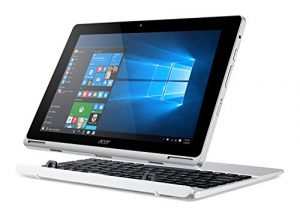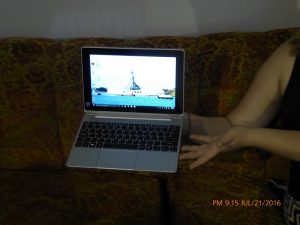Delightfully, I have had the opportunity to work with a few new models of laptop this month and thought I would pass on some of my delights and gripes. I’ll break this up into 2 groups; the tablets with keyboard, and the more classic full-size laptops. In all cases I am looking at inexpensive models; $150-$300 for the tablets, $275 – $450 for the laptops.

I played with a couple of the, now, 6 month old models of convertible laptops or tablets. In this field the Microsoft Surface machines are defining the standard; but I tried some of their competition. At the top of the list for me are the Acer switch series tablets (10, 11, and 12 inch); imagine a tablet that has a detachable keyboard for the times when you are actually doing some typing. The keyboard with the Acer has a surprisingly good feel though it is a tad small compared to a “standard” sized keyboard and is not backlit (I am not aware of their being a backlit option for this); it is also rigid so it works well in the lap, in the air or wherever you find comfy. I ordered my sample Acer with 4gb RAM, 64gb storage (solid state drive) and in the 10” size (weight vs size vs price favored this one for me). I noted that the resellers have the 10” model with the newer Intel Atom z8 series processor which seems a bit faster than the Z3’s common this winter and still in all the 11” and 12” models (the 12” can also be found with an i3 or i5 but at significant increases in price). The machine performed flawlessly allowing me to install a wide variety of windows software (office, WordPerfect suite, Lotus 1-2-3, Delorme mapping, various recipe apps, and various system testing and maintenance apps). As is my habit, I removed much of the free stuff along with McAfee antivirus, allowing Microsoft’s Defender to take over A/V chores and adding Malwarebytes to assist in the fight. Machine 2 was a Nextbook 11”; similarly, it has a nice keyboard that detaches, but its keyboard is also backlit (I found this quite helpful). There was a tad of flex to the keyboard which I found distracting but still very usable. The larger screen came with a bit of added weight (an issue to my thinking as it is harder to hold as a tablet for long periods). Similarly priced to the 10” Acer, it came with the Intel Atom Z3 processor and only 2gb RAM, 32gb solid state storage. Software compatibility was identical to that of the Acer (Windows 10 Home, also available in Android) but performance was slightly less impressive; quite adequate for a home or school machine. All machines (MS surface, Acer switch, Nextbook) function as true tablets with multi-touch, tilt sense (landscape and portrait display), built-in speakers, etc. Whereas the Surface and Surface pro 3 both would NOT support a USB DVD burner without auxiliary power (had to add USB power to the cable – very complicated), The Acer and Nextbook both support the DVD I use with no fuss and at half the price or less.

I also had the opportunity to setup and work with 2 of Lenovo’s low priced ultra thin laptops; The Lenovo B50 15” series (approx. $300 as ordered) is available with a wide range of processors, RAM, and hard drives; the one I ordered had no DVD, 4gb RAM, and 500gb 5400 rpm hard drive. The screen was quite bright and very crisp and easy to read, the keyboard has a decent touch and nice spacing; performance with the AMD A6 6300 quad core cpu was quite adequate (and would have been much better had I sprung for the SSD instead of the hard drive). The weight and feel of this machine are excellent; at 4.5 pounds it is light in your lap and is proving to be an excellent office computer (it runs MS office reliably and with no pauses or hesitation; but, this is not a gaming machine). I have also been working with the 17” G70 (similar machine 17” screen version) which I ordered with a slightly bigger cpu (quad core A8) and replaced the hard drive with an SSD (solid state drive). With the hard drive it performed much like its 15” brother; but, with the SSD replacing the hard drive it became a fantastically quick and responsive computer. The key spacing is a tad more to my liking and the larger screen is also a bonus but this all added 2 pounds to the weight. Still not a machine for gaming, it resumes instantly, cold boots in 8 seconds or less. For the Intel only customers you can also choose these machines with i3’s, i5’s and a few i7’s at a premium price. Having compared the A8 version with a machine sporting a quad core i7 I recommend choosing an SSD instead of spending gobs of cash on an i7. The AMD A8 system was twice as fast loading programs, booting up, switching apps, and even shutting down as a similar machine with an i7 and a 1Tb 7200 rpm hard drive (the latter cost $1200 compared to the AMD equipped model at $450).
Any of these machines should be available at your favorite retailer or on the web through Amazon, Tiger, Best Buy, Walmart, etc. Often you can find them with free shipping . I found that the best priced suppliers made me wait a week or more for shipping; while others could ship same day but at a higher price. One significant advantage to the laptops over the tablets is that they can be upgraded; when buying a tablet be sure and buy it configured as you are going to use it. All of these run the same programs and all of them do so quite adequately with the SSD equipped units being a fair bit quicker responding; if the small screen sizes are an issue, consider connecting one of these or one of the ultra-micro machines to a television of whatever size works for you.
